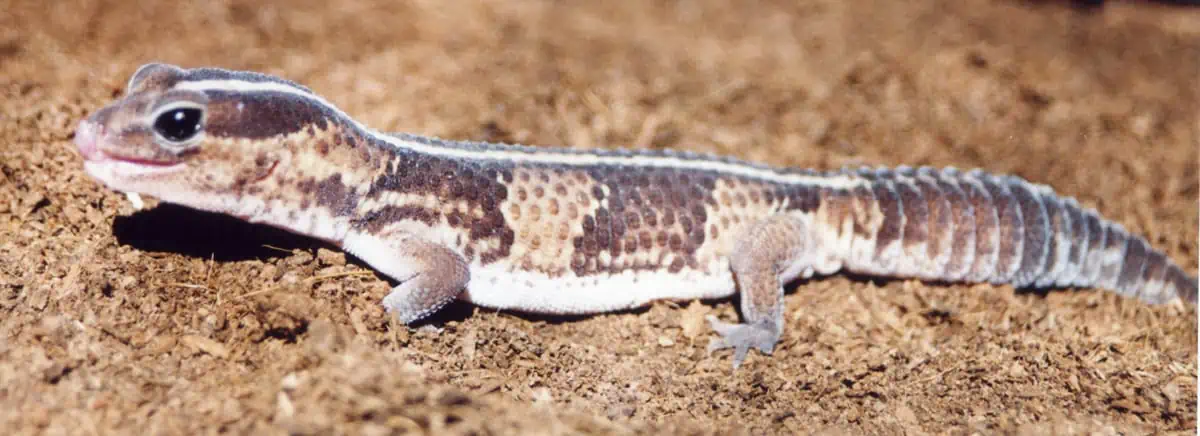African Fat-Tailed Geckos are distant cousins of the Leopard Gecko and they can be found in West Africa, from Senegal to Cameroon. They’re generally around 7-9 inches long and they can live anywhere between 10 to 25 years in captivity. This can make them a long commitment.
These geckos are also known to store fat in their tail, which helps them go days without food. In this article, we’ll talk about what their typical diet looks like.
What do African fat tail geckos eat? Diet Tips
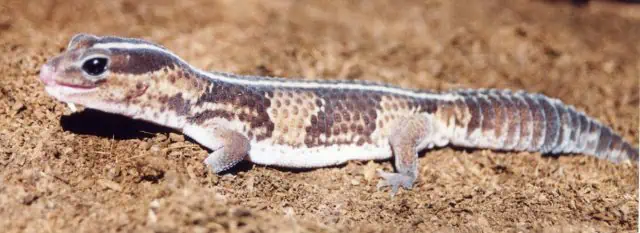
Just like you do with any other pet, you will need to take your gecko to your vet as soon as you got it. But make sure your vet is qualified to take care of exotic pets as a typical dog and cat vet might not have the necessary knowledge to spot problems early on.
After you introduced your new pet to your exotic vet, you will be able to find out if it has any allergies or problems you need to keep an eye on. And at the same time, your vet will walk you step by step through the African Fat-Tailed Gecko’s diet and what you need to do. A good vet will also offer you the exact portions you’ll need to feed your gecko.
It’s very important to follow your vet’s instructions as some insects are richer in fats than others and need to be cut back. Your vet will help you make a meal plan that is specifically made for your pet. Geckos can have different personalities and some might hate a type of insect that is typically popular in gecko meals.
You will need the help of an exotic vet to get your gecko to eat those kinds of insects or switch to something else. While the internet, and the place you got the African Fat-Tailed Gecko from, are good places for dietary information, nothing compares to a vet that has all of your gecko’s health records.
Types of insects recommended for their diet
African Fat-Tailed Geckos generally eat mealworms, crickets, and roaches, but you can introduce them to various new insects as long as they’re vet-approved. The insects should always be in perfect health conditions every single time you’re feeding your gecko.
If one insect is sick and you’re out of other options, let the African Fat-Tailed Gecko without food for a few more hours, or a day rather than feed it an insect that can get it sick as well. These geckos have similar tails to the Leopard geckos, which means they store fat in their tails and go for days without eating.
You should only do this in case of an emergency and not get into the habit of missing meals. A gecko should always be eager to get the insect it sees in your hand. If your African Fat-Tailed Gecko is not interested in food you should take it to the vet.
It’s also extremely important to feed your gecko ONLY live insects. If the insect has died, your gecko won’t even go near it as it’s like you’d give it a spoiled meal. The insects should always be alive so they can also bring out your gecko’s natural hunting instinct.
Another thing you need to keep in mind is that the size of an insect should always be smaller than the space between the gecko’s eyes. This is why you should avoid pinky mice as they’re too big for your lizard and they might cause choking.
Mealworms:
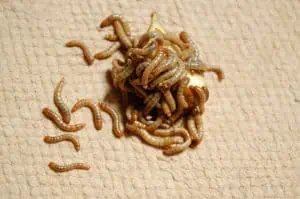
Mealworms are the larval form of mealworm beetles, which is a species of darkling beetle. They’re present on almost any gecko diet as they’re high in protein and lizards usually find them very tasty. More than that, they are very common to purchase as they’re often used for fish, birds, and as fishing bait as well. All you need is a good provider.
If you don’t have a professional that breeds mealworms around you, don’t worry, they’re commercially available as well. You can get them in bulk in containers that also contain bran or oatmeal that is used as their food. This keeps them fed and healthy for a very long time so the mealworms can get to you in perfect condition.
You will also notice that the mealworms you get commercially are bigger than the ones you get from your local supplier. This is because commercial growers are known to add a juvenile hormone into their feeding process. The main benefit of this hormone is that it maintains the mealworms in the larval stage for longer, but they also grow a bit bigger.
Buying mealworms can be a bit costly over time, which is why many lizard owners prefer breeding their own insects. And if you have more than one gecko, it’s highly recommended to get into home growing as it’s much more affordable.
Breeding mealworm beetles is not a problem at all and females can lay around 500 eggs in their lifespan. The eggs hatch in around 19 days and when they’re in the larval stage you can feed them vegetation and dead insects.
Crickets:
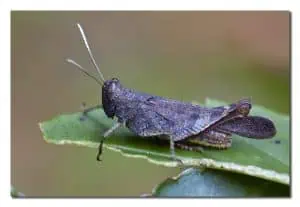
Another popular food for your African Fat-Tailed Gecko is crickets. They’re distantly related to grasshoppers and are found all over the world. These insects are also high in proteins and they make excellent food for your gecko. And since they’re so popular, you should be able to get them almost anywhere you are.
You can opt to gut load them or not, but it’s highly recommended you do as this will help your gecko even more. Crickets are typically the base of a gecko’s diet, which means you will need lots of them. If you don’t want to spend lots of money on crickets over the years, you can breed them at home as well.
But you should be very careful about the type of crickets you get. They also come in various species and some are easier to breed at home than others. Crickets are typically known for making lots of noise and if this is a problem for you, make sure you’re getting a mute species. Otherwise, you will have to keep them in a very secluded area of your home as they can be extremely loud and annoying.
For home breeding, you need a very good container as these little creatures are known to be very good at escaping. Make sure you provide the air they need but be careful while feeding them or taking them out for your gecko. You should also be careful when handling them as they have powerful jaws and will bite you if they feel threatened.
When it comes to feeding them, it depends on what species you’re getting. Some are completely herbivorous, while others are omnivorous. In captivity, you can get them on a diet of ground, commercial dog food, lettuce, and aphids.
Roaches:
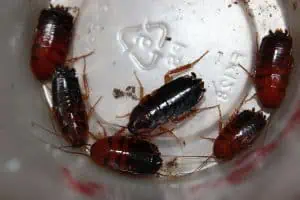
Another popular food for your African Fat-Tailed Gecko is roaches. These are some of the oldest and more invasive insects on the planet, which means there are plenty out there for your gecko. There are lots and lots of roach species and you need to make sure the ones you’re getting are vet-approved for your gecko. Some might be too big and cause problems.
The best thing about roaches is that they’re extremely easy to breed and keep at home. Most insects are very needy and if the temperature drops or is too high for a few hours, they can immediately die. On the other hand, roaches are quite resistant and can be kept at lower temperatures as well. They don’t stink and they don’t make any annoying noises.
As mentioned before, crickets have strong jaws and they might hurt your gecko if you’re placing too many crickets in its enclosure. But roaches are completely harmless and your African Fat-Tailed Gecko will love them.
But you should be careful about the species you’re getting. Besides being small enough for your gecko, they should also have a very hard time living in your home if they escape and hide. If you live in a place with a humid climate, make sure the roaches you’re growing at home need a very hot and dry environment. You don’t want a few roaches to turn into an infestation.
You can use an egg container as their home and place it in a bigger one that offers the air they need but they have no chance of getting out of. It’s also important to keep in mind that if you have a roach infestation you should never take your lizard and use it to get rid of them. This is because those roaches can have all sorts of bacteria and intestine parasites that will hurt the gecko. Always stick to bought or home-bred roaches.
Gut loading insects – Why and How
Gut loading an insect means feeding it highly nutritious food 24 hours before feeding said insect to your gecko. The big advantage is that the lizard will benefit from all those nutrients as well, ensuring that it leads a healthy and happy life. Sometimes, you will also have to dust the gut loading food and the insects themselves with a supplement powder to ensure the gecko gets everything it needs.
If you hate insects, it’s best to stick with buying them from a supplier and offering them to your gecko that way. This is because the way you breed and gut load the insects is very important. What goes into the insects will inevitably go into your African Fat-Tailed Gecko as well. And you will have to actually take care of the insects and make sure they also eat healthily.
Make sure your insects have access to good and highly nutritious food each day. And when it comes to gut loading, you can get the food online, from an exotic pet store, or from your insect supplier. These are also where you can find out how much special food you need to give each insect, depending on what you’re feeding your gecko that day.
If buying the gut loading formula is too expensive for you, there’s always the option of making it at home from scraps. The only thing you absolutely have to buy is a supplement powder that needs to be mixed in. You can get it from the vet or exotic pet store. The supplement powder should also be dusted on the insects themselves once a week or so.
You can make the gut loading formula at home by using a mix of a wide range of vegetables and fruits. This includes romaine, mustard greens, kale, collard greens, tropical fish flakes, sweet potatoes, peelings of potatoes, squash, oranges, apples, carrots, alfalfa, wheat germs, baby rice cereal, dry cat food, etc. Make a mix of some of these ingredients and add a reptile vitamin and calcium supplement for extra nutrition.
Gut loading is highly recommended but it’s OK if you don’t have the time to do it sometimes. The most important thing is for your African Fat-Tailed Gecko to get its insects when it’s time to eat. But if you don’t have the time or formula for gut loading, you can only feed them the insects.
What human food can Geckos eat?
Nothing! African Fat-Tailed Geckos are NOT capable of digesting the foods we eat as they’re strictly insectivores. This means that their bodies are specifically designed to digest only insects and drink water. Anything else can cause serious internal problems and you might have to run to the vet with your lizard. Your African Fat-Tailed Gecko should only eat insects, insects, and more insects.
A clear sign that African Fat-Tailed Geckos can’t eat vegetables is the shape of their skull. Their skulls and jaws have evolved and adapted to handle the consumption of meat. More than that, their skulls are also smaller and less pronounced than those that herbivores have.
You might think that fish is a good idea since it’s meat but you should never feed your lizard fish. First of all, African Fat-Tailed Geckos won’t ever get fish in their natural habitat, and second of all, fish contain lots of sharp bones inside. This can quickly lead to your gecko choking and even dying if a sharp bone gets where it shouldn’t be.
Raw fish from the store or wild-caught can contain parasites, which can get the gecko very ill as well. Don’t even try to give it “a piece of” something just because it’s too small to cause problems. Just because your gecko can’t communicate with you, it doesn’t mean it doesn’t have a tummy ache from human food.
If handling insects is a big No for you but you love lizards, you should look for one that eats fruits and vegetables. There are various lizards you can choose from and you won’t have to deal with any insects.
How often should I feed my African fat tailed gecko?
African Fat-Tailed Geckos should be fed around 3 or 4 times a week once they reach adulthood. When it comes to juveniles, you should feed them around once a day, and hatchlings may need to be fed a few times a day. It’s highly recommended to ask the keep you got the gecko from and your exotic vet. This will ensure that you’re neither starving nor over-feeding the gecko.
An adult African Fat-Tailed Gecko should be fed around 9 crickets or worms (or a mix of the two). It’s important to not feed the gecko insects that are bigger than the space between the gecko’s eyes. Otherwise, it can choke while eating.
But the general rule of thumb is feeding the gecko until it doesn’t seem eager any longer. A hungry gecko will immediately go after the insect and hunt it down. If it looks very bored and starts chewing slower and slower (and it’s healthy), it means it’s not hungry anymore.
When it comes to hatchlings that are under 4 months, you should only feed them 1/2-sized and smaller crickets. And the same rule goes for them as well. Keep feeding them until you notice that they’re full. They will typically stop at around 5 crickets.
How long can African fat tailed gecko go without eating?
African Fat-Tailed Geckos can go up to 10 days and even two weeks without eating anything. This is thanks to their fat tail, in which they keep storing fat. This is why you shouldn’t be alarmed if your gecko refuses to eat a meal or two. But if it refuses to eat and starts acting strangely, it might have a parasite and should be taken to the vet.
The fact that these geckos store so much fat in their tail also makes it hard to feed an African Fat-Tailed Gecko so much that it becomes overweight. But if its tail is wider than its body and its belly is not almost completely flat (and it hasn’t just eaten), your gecko might be getting a bit overweight. This means you should cut out the insects that have lots of fats.
You should keep in mind that African Fat-Tailed Geckos are capable of losing their tails when they feel threatened, and although it grows back, you should make sure it doesn’t happen. This is because if the gecko loses its storage of fat, it will need to eat more often.
Can African fat tailed geckos eat fruit?

African Fat-Tailed Geckos lack in having a cecum, which is an important body part that breaks down cellulose. This makes their digestive system impossible to digest fruits and vegetables. More than that, they have a short digestive tract, which is an alkaline tract. Creatures that are herbivores have a longer and acidic digestive tract that helps break down vegetables and fruits.
There are various lizards that eat either a mix of insects and fruits/vegetables or only fruits/vegetables. And if you don’t want to keep handling insects, you should look for one of them. African Fat-Tailed Geckos should not be fed fruits under any circumstance.
Some African Fat-Tailed Geckos will eat the piece of fruit while others will completely ignore it since it doesn’t move. If the piece of fruit is very small, it might only cause a bit of tummy pain and make the lizard feel uncomfortable. If you don’t notice anything unusual, it doesn’t mean that the gecko is not feeling ill. It can’t communicate with you.
Bigger pieces of fruits can cause some more serious digestive problems and you might have to take them to the vet in the end.
Fresh Water – How Much Do They Need?
African Fat-Tailed Geckos need a bowl of fresh water available all the time. They might not drink from it but it should never miss. Their humidity level requirements are between 40 and 60% and you need to make sure it remains somewhat stable. Geckos typically drink the drops of water that gather on the leaves, which is why they might seem like they don’t need a water bowl.
But sometimes, there aren’t enough droplets on the leaves and they will go to the water bowl. This will happen very rarely but it should always be there in case the gecko needs it. And you should also change it every single day and wash it thoroughly at least once a week.
Besides drinking, the gecko might use the water bowl to take a bath. This is why the water bowl should not have sharp edges and it should be pretty low and large. Otherwise, the gecko might get stuck inside the water bowl.
Why won’t my African fat tailed gecko eat?
There are various reasons why an African Fat-Tailed Gecko refuses to eat. The first reason is obviously a health problem, such as a parasite. You should take it to the vet, get rid of it, and nurse your little gecko back to health.
Another popular reason why geckos don’t eat is that they just changed homes. This can put a lot of stress on them. A new gecko can take up to 2 weeks to adapt, sometimes longer. And within this span of time, they will refuse to eat anything, which is pretty normal.
You should also make sure the insects you’re giving your gecko are alive as a gecko will rarely eat a dead insect. They see it like a spoiled meal and won’t bother with it.

